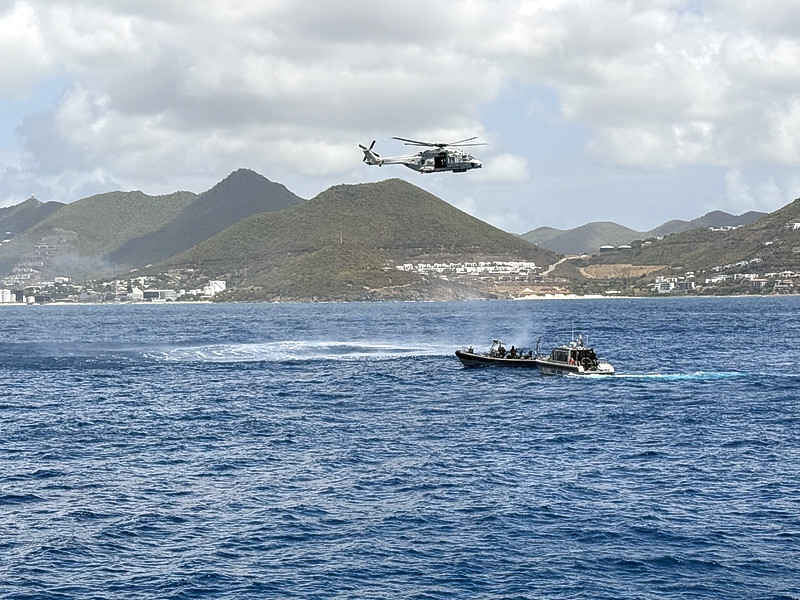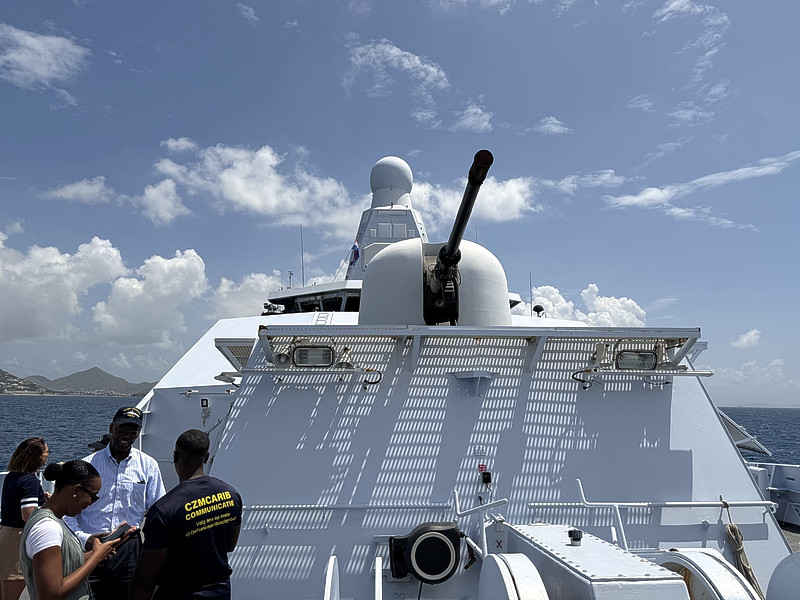In casual mode, from left: St. Maarten President of Parliament Sarah Wescot-Williams, Justice Minister Nathalie Tackling, VROMI Minister Patrice Gumbs, and ECYS Minster Melissa Gumbs.
PHILIPSBURG--A new naval base that will take over from the temporary facilities in Point Blanche and installation of a Coast Guard radar for 24/7 monitoring of maritime traffic are part of new developments to bolster safety and security in St. Maarten and the region.

Invited guests witnessed a number of interception demonstrations, this one with an NH90 helicopter.

One of the two guns on patrol vessel “HNLMS Groningen”.
The announcements were made by Commander of the Netherlands Forces in the Caribbean and Director of the Dutch Caribbean Coast Guard Rear Admiral Walter Hansen during an invitation-only sailing day and tour of patrol vessel “HNLMS Groningen” on Saturday, March 22.
“The plan is to have a naval base with permanent offices on land next to Chesterfields, to succeed the temporary container facility established in 2013,” Hansen explained during an interview with “The Daily Herald”. “The new base will house the current detachment of 29 marines and Marechaussee. It will be bigger and able to accommodate two Fast Raiding, Interception, and Special Forces Craft (FRISC) and vehicles, as well as meeting rooms, better working spaces for personnel, and maintenance workshops.”
Hansen envisages the new naval base opening in 2027. As far as training of marines is concerned, St. Maarten is adequate for individual physical training, but for training of an entire unit the very large facilities in Curaçao will be more appropriate, or facilities in Aruba, the USA, or Martinique.
As far as equipment for the Coast Guard station in St. Maarten is concerned, Hansen said it is sufficient.
“Four fast local Metal Shark interceptors is enough, but we lack the personnel for 24/7 operation. It is not material, but an increase of personnel to meet both 24/7 presence and intelligence-led policing was needed.
“This requirement is met by the new function book which has been presented recently to the government of St. Maarten. This function book includes an increase of approximately 20 additional jobs in St. Maarten, both in intelligence as well as in operations.”
Coast Guard radar
As for Coast Guard radar, coverage of the SSS Islands (St. Maarten, Saba, Statia) is anticipated. The hope is the first hurricane-proof Coast Guard radar will be installed in Saba in 2026, with subsequent Coast Guard radars installed in St. Maarten and St. Eustatius.
“It’s a very good system for monitoring maritime traffic, but radar is not a secret weapon. Distinguishing the difference between monitoring an innocent vessel and a suspicious vessel is not always clear and that needs a risk analysis or risk profile,” Hansen explained.
Given increasing tensions in the world, the uncertainty of the Russia-Ukraine war situation, defence of the Caribbean is paramount for Hansen, to be prepared and ready for any eventuality.
“When war escalates around the world, the Caribbean will not be exempt. It’s geo-political. You cannot exclude any part of the world,” he reasoned.
The drone threat
On the subject of the latest weapon of war, aerial drones, Hansen said defence forces are acquiring more counter-drone systems and money in the latest defence budget has been set aside for counter-drone systems in the Caribbean. Drones can be shot down or incapacitated by disrupting their navigation systems. Different types of drones are already in service in Defence and Coast Guard.
In general terms, Hansen said money spent by the Netherlands on defence has gone from 1.2% of gross domestic product (GDP) to 2.0% of GDP. “It’s difficult to know exactly what the specific budget for the Caribbean is, because it’s part of the entire Defence budget.”
Drug trafficking
As Commander in the Dutch Caribbean, Hansen contributes to the interception of cocaine coming from South America. The patrol vessel “HNLMS Groningen” is well suited to the task of intercepting drug traffickers. 2024 was a high point with 15,000 kilos of cocaine and marijuana intercepted. Responsibilities for the Coast Guard also include combating human trafficking, counter-terrorism and border security.
As quickly as traffickers are intercepted, more take their place to feed the insatiable demand. One of the methods for transporting narcotics at sea is using a type of submarine called a Semi-Submersible Propulsion Ship (SSPS). The vessel is able to lie very low on the surface hidden by the waves, and is very hard to detect by sight or radar.
“These particular craft are in the Caribbean and the Pacific and are costly to build. Criminals with plenty of funds have become more innovative. But it only makes sense if you have plenty of narcotics on board to outweigh the cost of building one.
“Until now the Transnational Criminal Organisation (TCO) will not engage with law enforcement agencies. They will try to avoid them or outsmart them,” Hansen said.
He acknowledges that the fight against drug trafficking is a very difficult challenge, but said it must continue as long as the demand for cocaine is there.
“We do our job pretty well. But my personal blame is on America and Europe, as that’s where the demand is. This trade is harming users and addicts. Secondly, it is harming the Caribbean region, causing destabilisation and criminality. It harms production countries, transit countries, and the economy. It’s not just about interception and repression. There must be more investment in preventive work to change the habits of users,” he insists.
According to Hansen, Europe now surpasses the US as the biggest consumer of cocaine, while the Netherlands is one of the biggest producers of chemical drugs. Production of cocaine is also very bad for the environment apparently. “The Netherlands is the Colombia of the world for the chemical version,” he said.
Relationship with the USA
Hansen sees no change in cooperation with the USA under the Trump administration and described the relationship as good.
“Our primary partner is the US Coast Guard. There have been no budget cuts that affect us or the Coast Guard. Our other priority partners in the region are France and Colombia.”
In conclusion, he listed his main concerns as threats from the geo-political situation in the
world, the TransNational Criminal Organisation (TCO), hurricanes and effects of climate change.
‘HNLMS Groningen’
The patrol vessel (not a frigate) was built in 2012 and belongs to a class of four similar vessels. The ship is designed for “low intensity conflict” and not for traditional warfare. It has guns that can be used for air defence if necessary, but no missiles or torpedoes. It has 90 crew members, including US and Dutch boarding teams as well as a helicopter detachment.
Boarding teams have Special Forces training and protocols to board suspicious vessels at sea to make arrests and ensure their own safety. The vessel is perfect for drug-trafficking interceptions and providing assistance during and after hurricanes.
Hansen said he was the first Commanding Officer of “Groningen” in 2012, literally receiving the keys at the shipyard.
Tour of the ship
Several prominent government officials, members of parliament (MPS), and representatives of partners such as the Fire Department, Customs, Police and local businesses were invited. The presence was noted of former St. Maarten Governor Eugene Holiday, Lieutenant Governor of Saba Jonathan Johnson, Justice Minister Nathalie Tackling, President of Parliament Sarah Wescot-Williams, Minister of Public Housing, Spatial Planning, Environment and Infrastructure VROMI Patrice Gumbs and Minister of Education, Culture, Youth and Sport (EYCS) Melissa Gumbs.
Representing French Saint-Martin were Préfet Cyrille Le Vély and Lieutenant-Colonel Hugues Loyez, Commandant of the Gendarmerie of Saint-Martin and Saint-Barths.
The tour included visits to the bridge, command centre, galley and dining areas for the crew, and the magazine room containing ammunition for the main gun. Out of bounds were crew cabins and the engine room.
Highlights of the tour included seeing the two guns on deck, a 30mm gun and 76mm gun, that are used for surface fire, as warnings to other vessels, but also for aerial defence if necessary. There was a demonstration of an interception of a go-fast boat by the Coast Guard Metal Shark assisted by the NH 90 helicopter. The helicopter performed several fly-bys over the ship.







